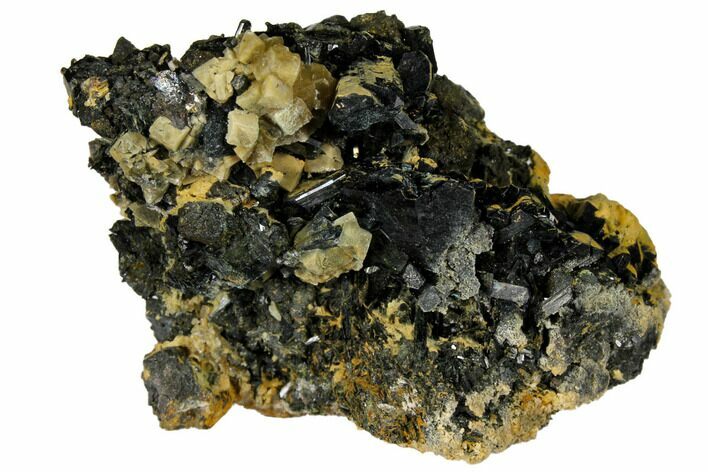This Specimen has been sold.
3" Epidote, Calcite and Magnetite Crystal Association - Peru
This is a beautiful association of quartz, calcite and magnetic magnetite crystals that was collected from the Cañete Province of Peru.
About Epidote
Epidote is a striking and often green mineral known for its complex crystal structure and vitreous luster. It is a calcium aluminum iron silicate that commonly forms in metamorphic rocks, particularly in regions that have undergone low to medium-grade metamorphism. The color of epidote typically ranges from pistachio green to dark green, although it can occasionally appear yellowish-green or even brown due to varying iron content.
Epidote crystals can appear in prismatic, slender forms or as aggregates, and they often exhibit striations along their length. The mineral’s translucent to transparent appearance and high refractive index give it an attractive, glassy shine.
It is commonly associated with minerals such as quartz, feldspar, and garnet, often forming in metamorphic rocks like schist and gneiss. It can also be found in skarn deposits alongside minerals like calcite, diopside, and amphiboles. These associations can provide insights into the geologic history and metamorphic conditions of the region. Epidote is found in locations worldwide, with notable sources including Austria, Norway, Pakistan, and parts of the United States. Collectors prize epidote for its unique green hues and well-formed crystal clusters.
Epidote is a striking and often green mineral known for its complex crystal structure and vitreous luster. It is a calcium aluminum iron silicate that commonly forms in metamorphic rocks, particularly in regions that have undergone low to medium-grade metamorphism. The color of epidote typically ranges from pistachio green to dark green, although it can occasionally appear yellowish-green or even brown due to varying iron content.
Epidote crystals can appear in prismatic, slender forms or as aggregates, and they often exhibit striations along their length. The mineral’s translucent to transparent appearance and high refractive index give it an attractive, glassy shine.
It is commonly associated with minerals such as quartz, feldspar, and garnet, often forming in metamorphic rocks like schist and gneiss. It can also be found in skarn deposits alongside minerals like calcite, diopside, and amphiboles. These associations can provide insights into the geologic history and metamorphic conditions of the region. Epidote is found in locations worldwide, with notable sources including Austria, Norway, Pakistan, and parts of the United States. Collectors prize epidote for its unique green hues and well-formed crystal clusters.
Magnetite is an iron oxide mineral with the chemical formula Fe₃O₄. It is the most magnetic naturally-occurring mineral on Earth and is an important iron ore. It has an iron content of up to 72.4 percent, which explains why it is such a commonly mined iron ore. Magnetite can be found in igneous, metamorphic, and sedimentary rock.
About Calcite Crystals
Calcite crystals are a form of calcium carbonate (CaCO₃) known for their diverse shapes, transparency, and vibrant range of colors. They typically form in rhombohedral, scalenohedral, or prismatic shapes, often with well-defined, sharp edges and glossy surfaces. Calcite crystals are often translucent or transparent, sometimes displaying a double refraction effect where objects viewed through the crystal appear doubled. They can appear in various colors—white, clear, yellow, pink, blue, green, and orange—depending on impurities or trace minerals.
A notable characteristic of calcite is its reaction with weak acids like vinegar, which causes it to effervesce, or fizz, as it releases carbon dioxide. This property makes calcite crystals a key tool in geological identification and studies. Calcite forms in many environments, from sedimentary rocks like limestone and marble to hydrothermal veins.
Calcite crystals are a form of calcium carbonate (CaCO₃) known for their diverse shapes, transparency, and vibrant range of colors. They typically form in rhombohedral, scalenohedral, or prismatic shapes, often with well-defined, sharp edges and glossy surfaces. Calcite crystals are often translucent or transparent, sometimes displaying a double refraction effect where objects viewed through the crystal appear doubled. They can appear in various colors—white, clear, yellow, pink, blue, green, and orange—depending on impurities or trace minerals.
A notable characteristic of calcite is its reaction with weak acids like vinegar, which causes it to effervesce, or fizz, as it releases carbon dioxide. This property makes calcite crystals a key tool in geological identification and studies. Calcite forms in many environments, from sedimentary rocks like limestone and marble to hydrothermal veins.
SPECIES
Epidote, Calcite & Magnetite
LOCATION
Cerro San Cristobal, Cañete Province, Lima Department, Peru
SIZE
3" wide
CATEGORY
ITEM
#132647
 Reviews
Reviews













